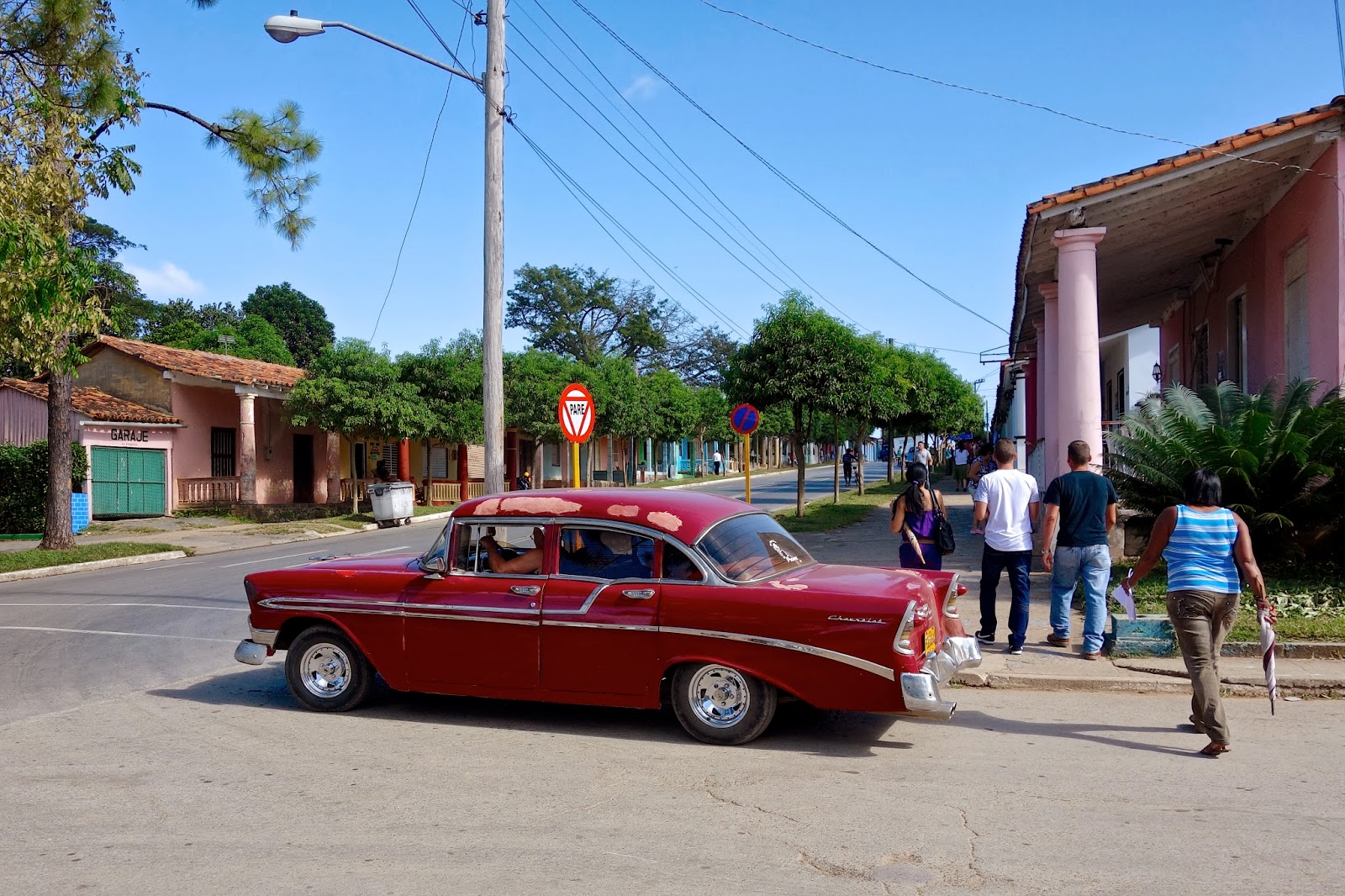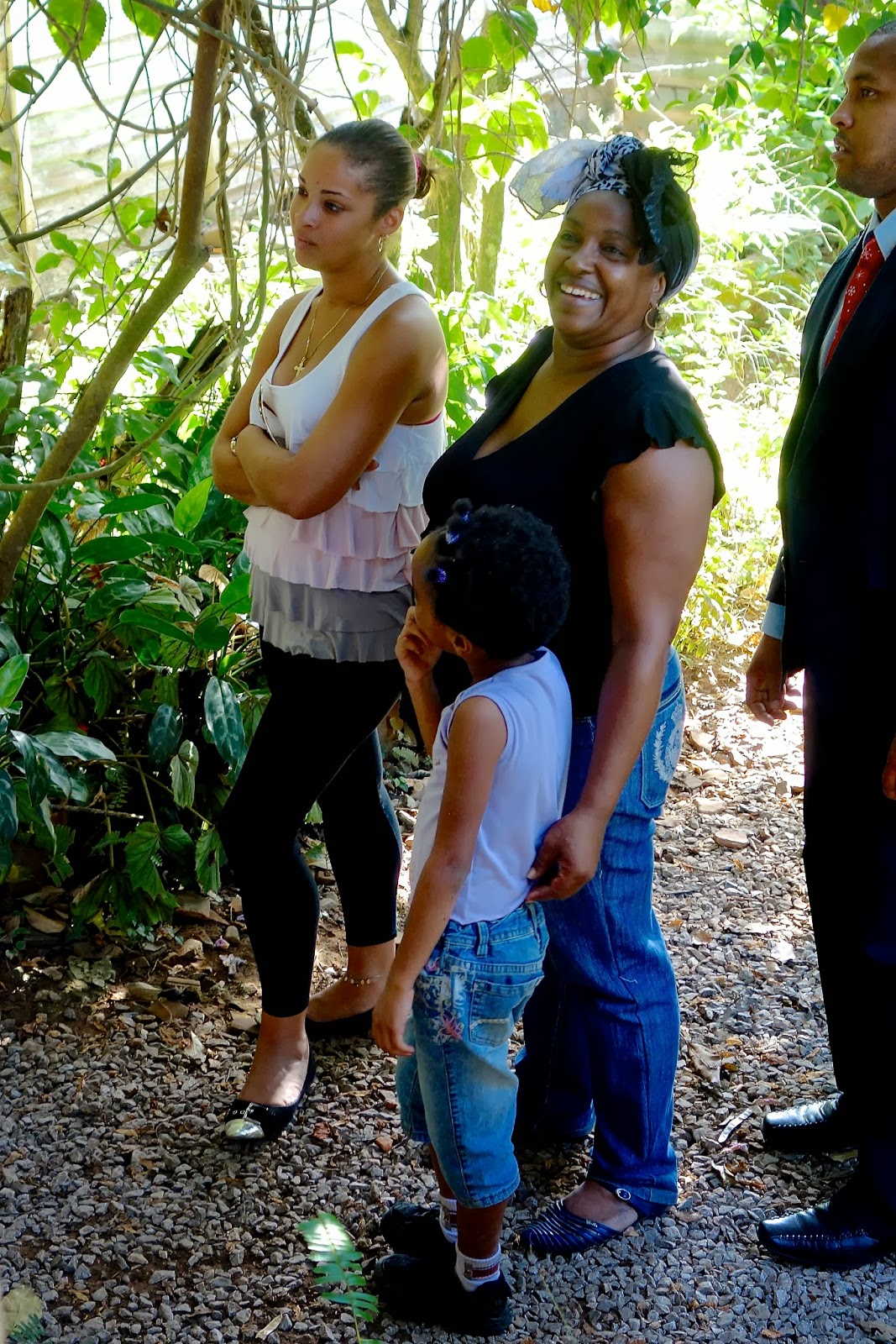Below, silvery fog, flowing slowly eastward, cotton-wool-like, tendrils snaking around and over mogotes, rejoining and refilling the valley floor. Sun was just touching the peaks, the valley still in shadow. One minute the fog might be so thin as to be a translucent film, with houses and barns visible through it, the next moment impenetrable and these same structures obscured. Visible, gentle flow, the morning windless and quiet, except for bird calls and dripping water. One by one, guests emerged onto their own balconies. Some knew, had been told ahead of time, and were setting up tripods surmounted by large cameras with heavy lenses. No one spoiled the moment by talking.
The magic endured maybe 30 minutes. As the sun climbed, the fog thinned and soon evaporated all together. The photographic sequence below is chronological, from dawn to sunrise:
On this morning we could see the hotel grounds and the valley below in full sunlight. Once the fog had dispersed, the day was cloudless. Tropical plants are everywhere. Many gardeners are needed to restrain overgrowth. Walkways between units are shaded and roofed by flowering vines.
Were there an award for "Most Scenic Swimming Pool"in the world, Hotel Los Jazmines would be a finalist:
Guests come here from los quatros esquinas del mundo. Besides those patrons who are duly registered, the hotel has a variety of unregistered guests, most of whom are "longterm". These unpaid guests may or may not be welcome, but they do add color and atmosphere:
The hotel features original art, including paintings and mosaics, and there is a small vendors' market in the parking lot with curios:
 |
| Vendor table, Hotel Los Jazmines |
We stayed only one night at Los Jazmines. ¡Que lástima! But a packed day, for folk art, travel, and other activities lay ahead, down the mountain in Viñales, and beyond.
In town, Michel parked the bus just off the main street, Salvador Cisneros. Along the street are residences, casas particulares (private homes offering guest stays), and businesses. Many people take advantage of the new economic freedom and run small businesses from their front portales, selling CD's, books, T-shirts, hats, jewelry, and knickknacks. The town square features a lively open-air market, a gallery, a cultural center, and an old church dating from the 1800's. There is a bar/cafe on one corner. In this square we met several locals, including the loquacious young man mentioned in a previous post. Most of the homes here are one-story and constructed of wood, with front portales. Frequently they are attached side-by-side, and have interior floor plans which are identical or nearly so. Exterior individuality is done mostly with color. Viñales is a multiethnic/mixed ethnicity community of around 25,000. Tourists abound. In many respects, it is a town a little bit outside of time.
Along Salvador Cisneros:
Side streets:
Local Viñalenos:
Viñales Plaza:
Town square market:
Corner bar:
 |
| Cerveza Crystal, 1 CUC |
Cultural center:
 |
| Unusual walking stick? |
On the west end of Salvador Cisneros we stopped in at Espacio Abierto, an artists' gallery and workshop. Local artists create pieces in different media, from tapestries to paintings to ceramics to jewelry. We met the director and his family, who live in an attached home. The gallery is on the street, and the working space is in a building behind, surrounded by flowers and trees.
 |
| MJ loved this fabric "painting" |
 |
| Yosmany signs it for her |
 |
| Yosmany's nickname is Chino: he is part Chinese |
 |
| High above the door, back porch |
 |
| Ubiquitous, beloved |
Garden, Espacio Abierto:
A few miles outside Viñales, up a hillside, sits an experimental, ecologically-sensitive organic farm (finca), intended to be entirely self-sustaining. From all appearances, it is. The farm, Finca Rachel, is north and east of town, and overlooks a remote part of Valle de Viñales called Valle del Silencio. The valley is aptly named. The farm folks treated us to a walking tour, demonstrating how the farm efficiently compartmentalizes the produce, the animals, and water; how plants that thrive together are mixed and matched, to optimize use of water and compost; and, best of all, what kind of lunch can be made from the sum of their products.
 |
| Mailbox |
 |
| Lunch in this thatched ramada |
Lunch featured fifteen or twenty unique farm vegetables and fruits, all organically grown, "ecológicalmente ecológical" as Rachel repeated frequently, and probably picked just before preparation. We could not begin to remember all of them. Fresh roasted pork, cooked on the spot, was the protein source. Dessert was a tapioca-like concoction. For everyone, the beverage was something Rachel calls "stress-free drink" – tropical juice flavored with anise, basil, lemon grass, cinnamon, and mint. Each table was provisioned with Havana Club 7-year rum, to convert "stress-free drink" to "care-free drink".
 |
| Aquí dos "stress-frees" |
 |
| The cutest waitress on the planet. She is also Rachel, and owns the place. |
 |
| Peggy and Rachel |
 |
| There is one toilet for guests. It, also, is ecológicalmente ecológical. |
 |
| The management. Siblings, too |
 |
| Some guests arrive in style |
The magnificent meal was prepared, in toto, in this attached kitchen:
And there was music:
Eastward, back toward Havana, we veered off Autopista Nacional on a side excursion to the small town of Puerta de Golpe.
This small community is home to artist and agriculturalist Mario Pelegrín. As related by the locals, Puerta de Golpe is a hurricane magnet and is destroyed about every 10 to 12 years. Mario Pelegrín is a community advocate who has created an organic farm, replete with dormitory and classes for young people who wish to come and learn sustainable agriculture. He also is a fine artist. Mario has constructed a compound of cabins, ramadas, and arboreal spaces for use by locals. Specifically, he has designed art programs, after school and weekends, for the local kids. On the shady, tree-covered grounds, is the sole small library in town, and the childrens' art pieces are shown here. Other adult artists of renown also work and display at this facility.
A foreign tour is a big event for Golpe. Mario described the facility (Peggy translating the Spanish), its functions and goals, and we the visitors gave to them new art supplies, brought from the US, for use by the children there. Townspeople gathered around, looking on and listening. For our gifts, we received their unabashed happiness, a more than even exchange.
The townspeople provided entertainment: the town dance club, a group of older citizens who were very obviously having a blast, a local singer Tomás who DJ'ed the show, and an all-inclusive closing rendition of "Guantanamera", several of us being conscripted to go on stage.
 |
| Mario Pelegrín |
 |
| Peggy Gaustad with Manuel Hernandez. Manuel is a cartoonist & ceramicist. Peggy gave him a signed collection of Pat Oliphant cartoons. |
 |
| Conviviality, a constant in Cuba |
 |
| Children's community library with children's art exhibits |
Three paintings by Mario Pelegrín:
 |
| Dave and MJ now own this one |
From Puerta del Golpe back to Havana required about 90 minutes. The time flew by as we enjoyed the scenery, and Peggy shared some Havana Club 7 with those of us willing to toast a great trip. We had just enough time to change and brush, before heading into Centro Habana for our "farewell" dinner.
Paladar La Guarida:
The restaurant is on the third floor of an old colonial building. The first floor is unoccupied, and in disrepair, but restoration has begun:
 |
| Front door, La Guarida |
 |
| Graffiti: emblem of the Habana Industriales, the NY Yankees of Cuba |
 |
| Image of Cienfuegos, Revolutionary hero First floor mural, long predates paladar |
 |
| We go up these stairs to La Guarida. It was rickety and required caution. |
The second floor is residential; restoration on this floor lags behind the rest of the building:
The restaurant was crowded, lively and very busy. The ambiance is colonial Spanish. The meal consisted of the prototypical Cuban cuisine, with quality. La Guarida has hosted many famous customers, from Europe and South America, and some from the US, and photographs of celebrities adorn dedicated walls. A photo gallery of illustrious visitors is on their website. Parts of the movie "Strawberries and Chocolate" were filmed here.
 |
| Please. Eat. Don't mind me. Just ignore. |
 |
| Buen provecho. |
We were able to acknowledge Peggy, Laura, Viviana and Michel, who had all worked diligently to make this trip an unforgettable one for us.
While we dined, a gentle rain came. The scene from the second floor balcony of the paladar was, ahem, painterly (Jonathan V, gotten your series going yet?):
 |
| Calle Concordia |
 |
| The evening done |
Sated, we returned by bus back to Hotel Parque Central. Back at the hotel, the scramble began: counting CUC's. Nervous calculations. Do we have enough money left to pay the necessary fees to negotiate Cuban customs successfully and be allowed to return to the US?








































































































Such special things, people and places you've shared. Thank you both!
ReplyDelete